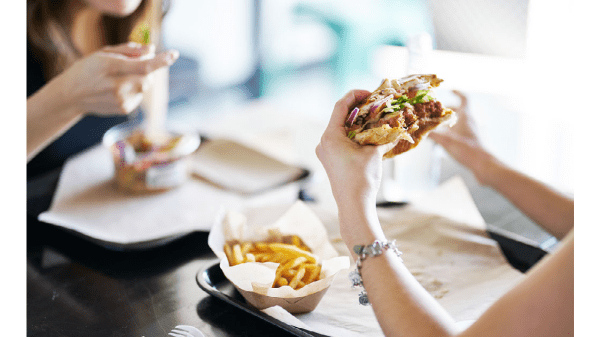I remember when fast food came to my hometown: Waterbury, CT, circa 1965.
At the age of nine, I rapidly discovered its delights. Every Saturday at noon, my dutiful father would drive down and pick up two hamburgers (plain; they cost 19 cents each then), french fries, and a vanilla shake.
Of course, that was fast food only in its latest iteration. During the Second World War, my mother’s family operated a diner opposite a foundry. (My mother and aunt hated the work.) I found one of the menus. If you had eaten there in 1944, you could have had a quick lunch of prime rib of beef with string beans for 45 cents.


This week’s Economist reminds me that fast food has a long and honorable history.
“Archaeologists have counted 158 snack bars in Pompeii, a city destroyed by a volcano in 79 AD—one for every 60-100 people, a higher ratio than many global cities today.” The word for “snack bar” was thermopolium, “a place that sells something hot.”
Dishes? One archaeological team “found duck bone fragments as well as the remains of pigs, goats, fish and snails in earthenware pots. Some of the ingredients had been cooked together rather than prepared separately as a Roman-era paella.”
The Economist also points out that in many eras, fast food was cheaper for the ordinary person than home-cooked food, if only because of the cost of fuel: “Today dining out is seen as an indulgence, but it was the cheapest way to eat for most of human history.”
The pandemic has thrown much of the future of the restaurant industry into question, but I think fast food is here to say.
For sit-down restaurants, the equation is different. “In recent weeks global restaurant reservations have been near their pre-pandemic levels,” says The Economist.
But I have my reservations (of another kind). In the first place, I have noticed a real decline in service in some restaurants. Not to mention other stratagems: a couple of weeks ago, a breakfast place charged me $12.79 for a skillet, when the price on the menu was $10.99.
When I complained about the mistake, the proprietor said, “It’s not a mistake. We haven’t had time to change the menus. Prices are sky-high!”
I informed him that (1) this was an extremely bad business practice and (2) I would not be back.
Whatever future sit-down restaurants have, I’m confident that fast-food places will continue to thrive.
They’re just too convenient for a people who are always in a rush.
What does this presage for the produce industry? Fast food, as a rule, has not put fresh fruit and vegetables at the forefront. I’m told McDonald’s has great salads, but I’ve never had one, and I don’t know anybody who goes there for the salads.
Yet I remain convinced that there is a real future for a vegetarian fast-food chain that would highlight produce far more than the burger and chicken joints.
My opinion: (1) this place would have to be good—really good. Even meat lovers would crave its dishes. (2) It should stay away from ideology (Morrissey’s “meat is murder”). I don’t want to be preached at when I go out to eat. That’s why I avoid certain fast-food chains that oil themselves with congratulations for their religious values. If I want religious values, I will attend the house of worship of my choice.
Meat consumption in the U.S. seems to be holding steady (as is the percentage of vegetarians in the populace), but it would seem that more and more people don’t feel the need to have it for every meal or even every day.
A cheap, attractive, convenient option spotlighting fresh fruit and vegetables might make a place for itself in future trends.



